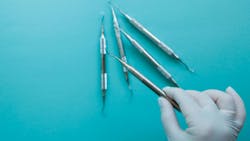The lost art of hand instrumentation
Listen to the article on our podcast!
Periodontal instrumentation is a fine motor skill that aids in the diagnosis and treatment of the periodontium. This skill uses specialized tools to remove hard and soft deposits such as biofilm and calculus from the crown and root surfaces of the teeth.
Upon graduation, many dental hygienists are just starting to develop proficiency in their instrumentation skills. However, with consistent practice, staying rooted in basic skills, and participating in hands-on workshops that enhances these skills and introduces techniques beyond the scope of their initial training, hygienists can become highly skilled in periodontal instrumentation.
At RDH Under One Roof 2023, Jessica Atkinson, Shelley Brown, and I led an instrumentation lecture called Raiders of the Lost Art. Our presentation drew attention to the waning interest in hand instrumentation due to updated technologies, which include ultrasonics, subgingival air polishers, and diode lasers.
Although these advancements can contribute to improved patient outcomes, there could be situations where they may not be suitable. As such, hand instrumentation continues to hold significance in today's dental hygiene practice. Key aspects of the presentation encompassed the technical nuances of hand instrumentation and other influencing factors concerning its application.
You might also be interested in
Selecting a high-quality exam glove with ergonomics and clinician safety in mind
Are periodontal files archaic or an essential component of periodontal therapy?
Ergonomics
Ergonomics holds a vital position in dental hygiene practice, particularly in improving proficiency in hand instrumentation. Having a solid understanding of ergonomics is vital for maintaining sound proper postural mechanics. This approach is critical to prevent musculoskeletal disorders (MSDs) and ensure career longevity.
Clinicians with good postural mechanics maintain the natural curve of their spine, use correct form during physical activity such as instrumentation, and balance muscle use. Ergonomics is not limited to the way one sits; it also takes into account the equipment and tools used, such as hand instruments. Here are some recommendations for choosing ergonomically designed hand instruments:
- Handle width >11 mm
- Handle weight <15 g
- Tapering near the shank
- Texturing and knurling on the handle
These features are designed to reduce pinch force, a crucial factor contributing to MSDs. Furthermore, the use of sharp tools helps reduce the amount of lateral pressure required, offering several benefits. These include decreased burnishing, reduced tissue trauma, enhanced efficiency, and the requirement for fewer strokes, ultimately resulting in decreased operator fatigue.
Glove fit
Ill-fitting gloves can result in excessive lateral pressure, which not only increases the risk of MSDs, but also significantly impacts performance. When selecting gloves, it's important to consider multiple factors, such as finger length, the length from finger tips to the cuff, overall comfort and feel of the material, and how well the glove fits across the palm.
There’s a new glove made with polychloroprene, which offers the softness of latex and the strength of nitrile without sacrificing comfort or dexterity. This new material is latex-free, made with a synthetic rubber that is safe for those with a latex allergy or sensitivity.
AAP guidelines and instrumentation selection
The updated guidelines from the American Academy of Periodontology (AAP) offer valuable insights for instrument selection. These guidelines suggest that a clinician's aramentarium should be influenced by factors such as clinical attachment level and the tenacity of the deposit. My cospeakers and I discussed protocols for selecting instruments and highlighted various designs including a range of sickles, area-specifics, and universal curets.
Additionally, we provided detailed explanations on the appropriate use of each instrument, taking into account the patient's condition. We addressed key questions of how, where, and why each tool should be used to enhance patient outcomes and boost operator proficiency.
We also introduced modified instrument designs that include tools with miniature working ends, extended shanks, and hybrid designs.
Stroke dynamics
Stroke dynamics underscore the importance of conserving the cementum during instrumentation. A few of the tenets of stroke dynamics include angulation, activation, and adaptation, which comprise the following key aspects:
- Angulation: Ideal 70–80 degrees
- Adaptation: 2–3 mm of insert/tip against the tooth structure
- Activation: Short 1–2 mm overlapping strokes in either a horizontal, vertical, or oblique adaptation
These guidelines enhance precision and efficiency in dental hygiene instrumentation. While discussing activation, the speakers stressed “slow down to speed up” to help clinicians remember that strokes must be kept between 1–2 mm in length to ensure effective and complete calculus removal.
Reinforcement scaling, although not traditionally taught in dental hygiene programs, is gaining recognition for its significant benefits such as additional instrument stability when applying additional lateral pressure and mitigating the risk of repetitive stress injuries (RSIs).
With the reinforcement technique, a clinician is unable to hold a mirror in their nondominant hand. The dominant hand adapts and angulates the blade against the tooth surface while the thumb or index finger from the nondominant hand is placed on the shank. Both hands exert control over the instrument stroke.
Know your hand instruments
Many of the new instrument designs benefit from advancements in cryogenic processing and metallurgy, which has led to instruments that stay sharper longer or are sharpen-free. These are offered by HuFriedy Group, American Eagle Instruments, PDT, Premier, Nordent Manufacturing, and LM.
How long do instruments last? Both stainless-steel and sharpen-free instruments have an expiration date. The problem in dentistry is that many clinicians use instruments, particularly stainless-steel designs, beyond their functional use. Variables affecting instrument lifespan include frequency of use, type of deposit, use of ultrasonics, frequency and proficiency of sharpening, and whether the instrument is used for its intended purpose. Traditional scalers and curets have a lifespan ranging from six months to one year, while scalers and curets made with advanced technology can last from 12 to 18 months.
Maintain your skills
Periodontal instrumentation is a critical skill in dental hygiene. Despite the rise in advanced technologies, the art of hand instrumentation remains relevant and necessary and should be honed throughout a dental hygienist’s career. Mastery of this technique can greatly enhance the precision and effectiveness of patient care.
While many dental hygienists start their careers with a basic level of competence, dedicated practice, continual learning, and hands-on training can help them become experts. The focus should not solely be on incorporating the latest technological advancements but also on refining fundamental skills and knowing when to utilize them for optimal patient results. In a rapidly evolving field like dental hygiene, the significance of these skills cannot be overstated.
Editor's note: This article appeared in the March 2024 print edition of RDH magazine. Dental hygienists in North America are eligible for a complimentary print subscription. Sign up here.
Joy D. Void-Holmes, DHSc, BSDH, RDH, is a hygienist with 25 years of clinical experience, founder of Dr. Joy, RDH, and creator of the Dental Hygiene Student Planner. She is program chair of the Fortis College dental hygiene program, holds a faculty position at the American Denturist School, and is a professional speaker and published author. She has presented continuing education courses nationally and internationally in the areas of instrumentation, ultrasonics, infection control, nutrition, and biochemistry, along with her signature keynote, Confidence and Courage.
About the Author

Joy D. Void-Holmes, DHSc, BSDH, RDH
Joy D. Void-Holmes, DHSc, BSDH, RDH, a leader in oral health-care with nearly 30 years of experience, excels in dental education and hands-on workshops. Founder of Dr. Joy, RDH, and JELL-ED, she champions self-care, personal boundaries, and cutting-edge clinical techniques. With degrees from Howard, Maryland, and Nova Southeastern, Dr. Joy shapes the future of dental hygiene as a consultant examiner, board member, and advocate for innovation and professional growth.
